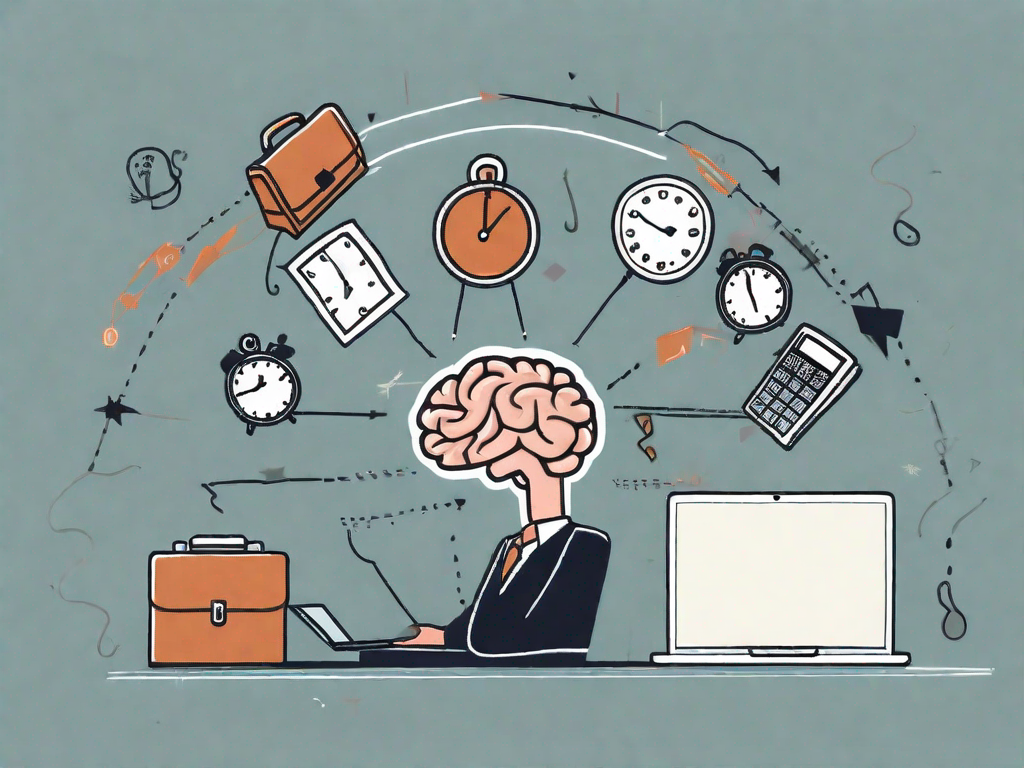
Multitasking is Bad for Your Brain
In today’s job market, multitasking is the norm. “Ability to multitask” is listed as a “must” in nearly every job description. We pride ourselves on our ability to juggle multiple tasks simultaneously, believing that it makes us more efficient and productive. However, recent research suggests that multitasking is not beneficial. In fact, it’s bad for your brain, and bad for business.
What is Multitasking?
When we talk about multitasking, we often refer to situations where we’re trying to do two or more things at the same time. For example, answering emails while participating in a conference call, or writing a report while chatting on instant messaging. It seems like a time-saving strategy, but it comes at a cost.
Our brains are incredible organs capable of processing vast amounts of information, but they have their limits. When we engage in multitasking, we are essentially asking our brains to divide their attention and switch between different tasks rapidly.
Imagine you’re trying to write an important email while also listening to a colleague’s presentation. Your brain is constantly shifting its focus between the words on the screen and the words being spoken. This constant switching can lead to decreased productivity and increased errors.
Furthermore, when we multitask, we often underestimate the time it takes to complete each task. We may think we’re being efficient by tackling multiple tasks simultaneously, but in reality, we’re spreading ourselves thin and compromising the quality of our work.
The Prevalence of Multitasking in Modern Society
Multitasking has become deeply ingrained in our daily lives. We are accustomed to having multiple screens and devices vying for our attention. We feel the need to constantly switch between tasks to stay updated and connected. Why do we feel this complusion? Why is it even expected of us?

Consider the iconic Swiss Army Knife. Depending on the model, it may have anywhere from four to 38 functions. But you’re only ever using it for one thing at a time! You won’t be able to use the can opener, corkscrew, and flathead screwdriver simultaneously.
Research has shown that multitasking can lead to a decrease in cognitive performance and an increase in stress levels. It can lead to mental fatigue, decreased focus, and difficulty in retaining information.
Moreover, it stands to reason that multitasking will have negative effects on our personal and professional relationships. When we are constantly dividing our attention between tasks, we are not fully present in our interactions with others. There is no way to practice active listening if you’re multitasking. This can lead to misunderstandings, decreased empathy, and a lack of meaningful connection.
It’s important to recognize the limitations of multitasking and find strategies to manage our tasks effectively. Prioritizing and focusing on one task at a time can lead to increased productivity and better overall outcomes.
The Impact of Multitasking on the Brain
Why is multitasking is so challenging for our brains? It all comes down to how our brain processes information. When we focus on a single task, our brain can allocate all its cognitive resources to that task, allowing us to perform at our best. However, when we divide our attention between tasks, our brain struggles to process information effectively.
Research has shown that multitasking negatively impacts our cognitive functions, such as attention, memory, and problem-solving. When we try to juggle multiple tasks, our brain becomes overwhelmed with the constant influx of information. As a result, our ability to concentrate diminishes, making it difficult to stay focused on any one task for an extended period of time.
Multitasking can also impair our decision-making abilities. When we switch between tasks, our brain needs time to refocus and reorient itself. This transition period can lead to errors in judgment, as we may not have all the necessary information readily available. In fact, studies have found that individuals who multitask are more likely to make impulsive decisions and overlook important details.
But the negative consequences of multitasking don’t stop there. Continual multitasking can have long-term consequences for our brain health. Studies have found that individuals who engage in heavy multitasking have lower gray matter density in certain brain regions associated with cognitive control and emotional regulation.
Gray matter is responsible for processing information and making connections between different brain regions. A decrease in gray matter density suggests that multitasking may contribute to cognitive decline and increased susceptibility to mental health issues. It’s a sobering thought that our attempts to be more productive may actually be harming our brain in the long run.
Multitasking and Productivity
Contrary to popular belief, multitasking does not make us more productive. In fact, it can hinder our ability to effectively complete tasks. Let’s debunk the myth of multitasking efficiency.
When we think of multitasking, we often imagine ourselves juggling multiple tasks simultaneously, believing that this allows us to get more done in less time. However, research has shown that switching between tasks actually reduces efficiency. Each time we switch tasks, there is a “switching cost” – a cognitive price we pay in terms of time and mental effort. This cost accumulates and can significantly slow down our overall productivity.
Imagine you are working on a project that requires your undivided attention. Suddenly, an email notification pops up on your screen. You decide to quickly respond to it, thinking it will only take a minute. However, once you switch your focus to the email, your train of thought for the project is interrupted. It takes time to regain that focus and get back into the flow of your work. This interruption not only consumes the time it takes to read and respond to the email, but also the additional time needed to refocus on the original task. This switching cost can be substantial, especially when we encounter frequent interruptions throughout the day.
The Myth of Multitasking Efficiency
Despite the common belief that multitasking allows us to accomplish more, the reality is quite the opposite. Multitasking may give us a sense of productivity, as we feel like we are constantly busy and attending to multiple things at once. However, this illusion of productivity is often accompanied by a decrease in the quality of our work.
Consider a scenario where you are trying to write an important report while also participating in a conference call. As you listen to the discussion on the call, your focus on the report becomes divided. You may miss crucial details, struggle to articulate your thoughts effectively, or even mix up information from the call with what you intended to include in the report. This lack of focused attention leads to errors, misunderstandings, and a decrease in the overall quality of your work.
The Cost of Multitasking in the Workplace
In a business setting, multitasking can lead to decreased productivity, increased errors, and higher levels of stress. When employees are constantly switching between tasks, their ability to focus and produce high-quality work diminishes. This can result in missed deadlines, poor decision-making, and ultimately, lower business performance.
Instead of accomplishing more in less time, multitasking often leads to a phenomenon known as task switching cost. This refers to the time and mental effort required to shift attention from one task to another, resulting in a loss of efficiency and accuracy.
Furthermore, multitasking can create a sense of overwhelm and stress among employees. Constantly being pulled in different directions can lead to feelings of burnout and decreased job satisfaction. This, in turn, can have a negative impact on employee morale and retention.
Strategies to Minimize Multitasking in Business Settings
Organizations can take steps to minimize multitasking and promote a more focused work environment. Providing clear priorities and expectations is crucial in helping employees understand which tasks should take precedence. By setting realistic goals and deadlines, employees can better manage their time and avoid the temptation to multitask.
Encouraging time-blocking techniques is another effective strategy. This involves allocating specific time slots for different tasks or projects, allowing employees to fully concentrate on one task at a time. By dedicating uninterrupted blocks of time to important tasks, employees can enhance their focus and productivity.
In addition, promoting open communication within the workplace can help minimize multitasking. Encouraging employees to voice their concerns or ask for assistance when feeling overwhelmed can prevent them from taking on too many tasks at once. This fosters a collaborative and supportive work environment, where individuals can rely on each other for help and guidance.
Various tools and techniques can help us avoid the temptation of multitasking. Time-management apps, such as Pomodoro timers, can help us break work into focused intervals. Creating task lists and prioritizing tasks can assist in maintaining focus on one task at a time. Additionally, practicing mindful work habits and setting boundaries with technology can promote concentration and minimize the urge to multitask.
Furthermore, providing opportunities for breaks and quiet time for deep work can help combat the negative effects of multitasking. Encouraging employees to take regular breaks, engage in physical activity, or practice mindfulness techniques can improve their overall well-being and ability to concentrate on tasks.
The Alternative: Focused, Quiet Work
When we concentrate on one task at a time, we give ourselves the opportunity to fully engage with it. By eliminating distractions and dedicating our attention to a single task, we can achieve a state of flow – a state of heightened focus and productivity. Focused work allows us to dive deeper into a task, resulting in better quality output and a sense of accomplishment.
The fact is, too many employers preach the value of work/life balance and mental wellbeing, only to implicitly (or explicitly) demand multitasking from everyone, all the time. We’re conditioned to expect meetings from morning till night, messages at all hours, and no-boundaries communication platforms.
The Quiet Workplace challenges conventional beliefs. Our mission is to make silence the secret ingredient of the workday; to make quiet time practical, powerful, and realistic through a series of simple principles, practices, programs, products, and places that will help professionals, teams, and organizations lower the volume of what wears and tears them.
Stop making the “ability to multitask” a requirement in job descriptions, and start making quiet time for focused work, thinking, and planning. It’s good for your brain, and good for business.






